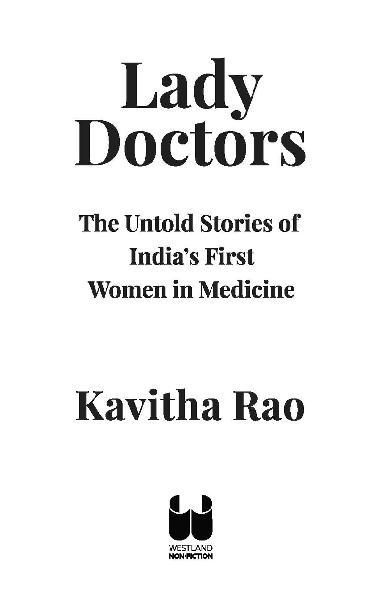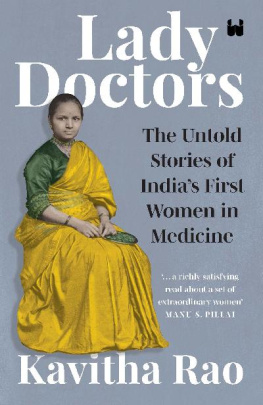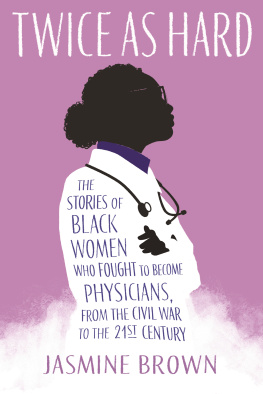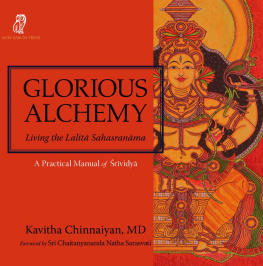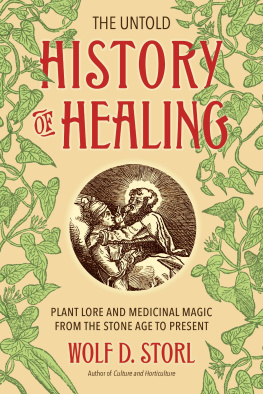First published by Westland Non-Fiction, an imprint of Westland Publications Private Limited, in 2021
1st Floor, A Block, East Wing, Plot No. 40, SP Infocity, Dr MGR Salai, Perungudi, Kandanchavadi, Chennai 600096
Westland, the Westland logo, Westland Non-Fiction and the Westland Non-Fiction logo are the trademarks of Westland Publications Private Limited, or its affiliates.
Copyright Kavitha Rao, 2021
ISBN: 9789390679058
The views and opinions expressed in this work are the authors own and the facts are as reported by her, and the publisher is in no way liable for the same.
All rights reserved
No part of this book may be reproduced, or stored in a retrieval system, or transmitted in any form or by any means, electronic, mechanical, photocopying, recording, or otherwise, without express written permission of the publisher.
You ask me, why I should do what is not done by any of my sex? To this I can only say that society has a right to our work as individuals. If anything seems best for all mankind, each one of us should try to bring it about.
Anandibai Joshi, Indias first woman doctor
It was 24 February 1883. A diminutive eighteen-year-old girl stood up before an entirely male audience in the town hall of Serampore, West Bengal, seeking approval for an unprecedented plan. Her presence by itself was worthy of notice. At the time, women did not leave their homescertainly not to address men. But what this solemn young woman was saying was even more unusual. She was announcing her intention to sail across the ocean, breaking caste rules and courting ostracism, to study medicine in the US. Alone. The first Indian woman to ever do so.
The girl was Anandibai Joshi, who would eventually become Indias first woman doctor. On that crucial day, she gave such a convincing performance that her speech was later turned into a pamphlet. Why do I go to America? she asked. I go to America because I wish to study medicine. The want of female physicians in India is keenly felt in every quarter. Anandibai went on to explain that the restricted freedoms allowed to Hindu women in India, and the harassment she had faced as she walked to school, made it near impossible for her to study in India. To continue to live as a Hindu and go to school in any part of India is very difficult.
The maverick Anandibai was followed by other fearless women. Kadambini Ganguly battled colonialism and defamation as a whore to become Indias first practising doctor, all while bringing up eight children. Rukhmabai Raut escaped the marriage she had been forced into as a child by divorcing her husband, unheard of for Hindu women at the time. They made medicine an acceptable profession for women, and later, even a respectable one.
Little is known of these unsung women, commonly called lady doctors. They do not appear in our textbooks or museums, and have been largely left out of Indian history. A crater on Venus is named after Anandibai, but not a single road or school in India. Anandibai and Rukhmabai have had biographies written about them in Marathi; Rukhmabai was the subject of a 2017 film by Anant Mahadevan and, in 2019, Sameer Vidwans directed a Marathi film about Anandibai. Nevertheless, these women are hardly household names across India, in the way that Sarojini Naidu or Rani Lakshmibai of Jhansi are.
These pioneers would inspire other women to become doctors, women who would go on to found institutes that shaped modern India. In West Bengal, fiery Haimabati Sena mere child of ten when widowedwould overcome huge challenges to follow in Kadambinis footsteps. Chennais Muthulakshmi Reddy would become a fervent social reformer, abolish the devadasi system and go on to establish the Adyar Cancer Institute. In the princely state of Travancore, Mary Poonen Lukose would become a royal physician, Indias first surgeon general and first woman legislator. None of them would be remembered in any significant way, and some, like Haimabati, would be completely erased from memory.
This erasure has consequences. Men will argue that women have made no contributions to science. The truth is that they were often not allowed to. Those that were allowed to study have been forgotten or their achievements diminished. Thus, a generation was reared on the trope that women made worse scientists than men because they were not ambitious, determined or tough enough. Meanwhile, in reality, a host of ambitious, determined, tough women were storming medical colleges, topping their classes and making scientific advances, which was brushed under the carpet.
Their forgotten lives hold many lessons for modern women. How did they defy the popular idea that women were unfit for medicine? How did they persuade medical colleges to open their doors? What did they do to escape the suffocating bonds of family, caste and society? How did lady doctors go from being called whores to highly respected professionals?
All these women had something in common: they were fighters. And they certainly had plenty to fight. In the 1860s, upper-caste Indian women barely left the house, let alone travelled overseas to study. Educating a girl was considered unnecessary; educating them in the sciences even more so. Amongst Hindus, it was considered unlucky to let girls remain unmarried after the age of ten. Girls would often be married and widowed before they were twelve, then spend the rest of their lives in poverty. Across the world, medical colleges banned women from attending.
They faced intense opposition: religious, caste-based and patriarchal. They were stoned, harassed and jeered at. Some of the most feted men in Indiaincluding the beloved freedom fighter Bal Gangadhar Tilakopposed higher education for women. Brilliant women doctors who won medals at university were forced to give them up because men felt threatened.
It is to uncover their hidden stories that I wrote this book. But it was not as easy as it sounds. Like most women of their time, many of them did not keep diaries or write their autobiographies. The memoirs they did write were not thought worthy of preserving, and were lost or destroyed. Haimabati Sen wrote her autobiography, but it remained hidden for years in an old trunk, because no one thought it worthy of notice, not even her family. Some, like Anandibai Joshi, did write letters, but they were in Marathi, and thus unavailable to many as translations were hard to come by.
Often, the flamboyant husbands of lady doctors monopolised the narrative. While some were supportive, others, like Haimabatis, were feckless drunkards. Anandibai Joshis domineering and abusive husband, Gopalrao Joshi, was given the credit for her success. Similarly, Kadambinis husband, the prominent Brahmo reformer Dwarkanath Ganguly, was much praised for his encouragement of her ambitions. His extensive writings and letters surviveprobably carefully preservedwhile hers do not.
By the time of Muthulakshmi Reddy and Mary Poonen Lukose, in the 1920s, women had emerged from the shadows of their husbands. But Indian libraries still carry little or nothing about lady doctors of the time. It is a terrible injustice that the writings of Indian lady doctors are mostly to be found in libraries in the UK and US, and not easy for Indians to access. There are several about whom we know nothing beyond their names.
